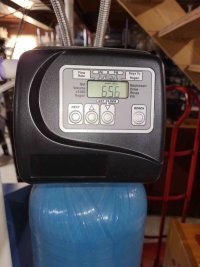Milanomike
Member
It's been a while since I've been here as I've not had any problems......that I couldn't fix or figure out related to plumbing!
I installed the water softener about 12 years back, other than a leaking draw line initially it has worked flawlessly. I have a whole house sediment filter feeding a charcoal filter before the water softener for info, maybe this has helped.
Anyhow, the unit just started filling the brine tank with water in the past month or so as I check the tank regularly. Attached photo of my valve.
I have checked the following:
- the draw or brine fill line for a leak, seems good.
- the brine valve on top of the head that the brine feed line connects to, all clear, can blow thru it
- the injector (red one), all clear, no blockage evident
- drain line valve on top the head, all clear, can blow thru it
- float in chamber in brine tanks seems fine
- I can see water going down when in draw mode, but also disconnected line put it in bucket of water to make sure it was sucking/drawing. Seems fine to me.
At some point I will clean out the brine tank, I don't think I have a salt bridge, as the brine draw seems to work.
Looking for help on what else I should check. Yeah, I can throw parts at it, like the spacer stack and 2 pistons, but would like to figure this out first.
Also, no settings have been changed other than to extend the days for recycle as kids moved out and we use less water.
Thanks in advance for any help.
Mike
I installed the water softener about 12 years back, other than a leaking draw line initially it has worked flawlessly. I have a whole house sediment filter feeding a charcoal filter before the water softener for info, maybe this has helped.
Anyhow, the unit just started filling the brine tank with water in the past month or so as I check the tank regularly. Attached photo of my valve.
I have checked the following:
- the draw or brine fill line for a leak, seems good.
- the brine valve on top of the head that the brine feed line connects to, all clear, can blow thru it
- the injector (red one), all clear, no blockage evident
- drain line valve on top the head, all clear, can blow thru it
- float in chamber in brine tanks seems fine
- I can see water going down when in draw mode, but also disconnected line put it in bucket of water to make sure it was sucking/drawing. Seems fine to me.
At some point I will clean out the brine tank, I don't think I have a salt bridge, as the brine draw seems to work.
Looking for help on what else I should check. Yeah, I can throw parts at it, like the spacer stack and 2 pistons, but would like to figure this out first.
Also, no settings have been changed other than to extend the days for recycle as kids moved out and we use less water.
Thanks in advance for any help.
Mike


